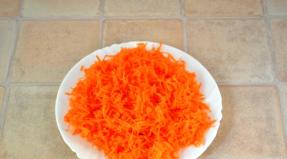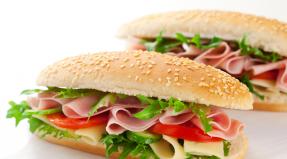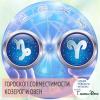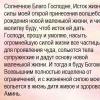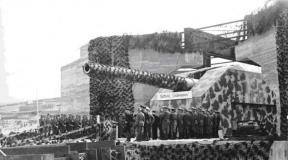Dice. Types of dice - dice, dice, dice. Project and research activities Mysterious behavior of three dice
At some stage of development, bones turned from an attribute of divination into a tool of gambling. To do this, unknown craftsmen began to make dice from wood, stone, elephant tusk, etc. History convincingly shows that gambling with dice appeared long before the construction of the Cheops pyramid, i.e. 3000 years before our era, they already were. Samples of ancient Egyptian, ancient Greek, Roman, Chinese gaming dice are stored in various museums of the world. Most often they were in the form of a cube with recesses on the faces, denoting numbers from 1 to 6. Although there are samples in the form of other polyhedra: a straight prism with a different number of side surfaces; cuboctahedron with 14 faces; in the form of a prismatic top and others. To this day, dice in the form of a cube have not gone out of use, the rest are kept as museum exhibits. The advantages of the cubic shape of the dice have quite reasonable explanations:
Only a regular polyhedron ensures complete equality of all faces;
Of the five regular polyhedra that exist in nature, the cube is the easiest to make;
It rolls easily, but not too much. The tetrahedron rolls more difficult, but the dodecahedron and icosahedron are so close in shape to a ball that they quickly roll away.
The Western standard requires that the sum of the numbers on opposite faces be equal to seven: 6-1.5-2, 4-3. There are only two different ways of numbering dice, one being a mirror image of the other, and moreover, all modern dice are numbered the same.
If you hold the die so that the three numbers 1, 2 and 3 are visible, then the numbers will be arranged in the reverse order of the clockwise movement.
Why were these games specifically gambling, that is, they implied some kind of bet in the game, money or things that could be won or lost?
Probably because when throwing a dice it was not necessary to think - he threw it up and surrendered to chance. If you do not sweeten this action with the opportunity to hit the jackpot, then there is simply no other meaning in the stupid throwing of bones. Unlike, for example, chess, where the very long process of the struggle of minds brings satisfaction, people play with pleasure without additional incentives, and even then not always.
Gambling with dice, oddly enough, has benefited science, served as an impetus for the development of combinatorics and the mathematical theory of probability. This theory began with the study of various types of gambling, in order to establish patterns in random events, determine the probability of winning or losing. In the fight against randomness, this knowledge does not change anything, but it can warn, make it possible to realistically assess your chances of winning, and only then decide whether to get involved in the game or prudently refuse. Knowledge of chess openings, chess theory, will be useful in the game itself and can lead to victory, but knowledge of probability theory will not affect either the dice or the ball in American roulette, you will be left alone with chance. Although it is still interesting to know that randomness has its own patterns.
Dice games can take place with a different number of dice thrown at the same time. Let's start with one bone.
The game is primitive
The primitive single-dice game consists of players taking turns throwing it and the one with the most points wins. If the points are equal, the players repeat the throw. It is unlikely that anyone will be interested in such a game, so this procedure is used more often not for the game itself, but when drawing lots in some other games or cases.
But even this simple option allows us to train our logical thinking. In the history of the development of the mathematical apparatus of gambling, there were many cases of incorrect logic that led to incorrect results. Let's consider a similar example.
When a single dice is rolled, the probability of a 1 appearing is 1/6. At the second toss - too. So, if you make two throws, then the probability of a unit appearing at least once (on the first throw or on the second) is 1/6+1/6=1/3. Arguing similarly, it turns out that for six throws, the probability of a 1 falling at least once out of six is equal to one (1/6-6=1), i.e. is a valid event. We can apply this reasoning to any of the numbers from 1 to 6, and conclude that every number in six tosses is bound to come up. On the other hand, experience tells us that this is not the case. Throw a die six times and it is unlikely that each of the possible numbers will fall out exactly once. What is the fallacy of reasoning? The saying "one came up at least once in two rolls" actually breaks down into several different events:
Dropped the first time and didn't drop the second (1/6-5/6) or
Didn't roll the first time and rolled the second (5/6-1/6) or
Dropped the first time and the second too (1/6-1/6).
The corresponding probability is calculated as 5/36+5/36+1/36-11/36, which is slightly less than 1/3. For six rolls, it is better to start counting in a different way. The probability that 1 did not fall out in one throw is 5/6, in two throws 5/6-5/6, respectively, the probability that 1 did not fall out in six throws is (5/6)6. So the probability that it fell out at least once in six throws is 1-(5/6)6 = 0.66510.
Add-on game
The first player rolls the die and adds the number on the top face to any number on one of the four side faces. His opponent adds up all the other numbers on the three side faces. The lower bound is not taken into account. The second player then rolls the die and they do the same count. The winner is the player who, after the throws of both players, will have more total amount. A small opportunity was added to the blind case for the player to choose one of the side numbers, although what to choose there - you need to take the largest. In addition, you will have to add the numbers in your mind, it turns out that thinking has been added.
Flips of the bone
For this game, again, one dice is needed. The first player names any number from 1 to 6, and the second player rolls a die. Then they take turns flipping the bone over its edge in either direction for a quarter of a full turn. The number of points named by the first player is added to the number of points that fell on the top face after throwing the die and after each turn of the die. The player who manages to reach the sum of 25 points at the next turn or forces the opponent to exceed 25 points at the next turn wins.
In only the third step, remaining with one die, we came to the need to think seriously.
What number should the first player name in order to win with the greatest chance?
Two-dice games have been so popular for centuries that they have their own historical names and specific terminology.
Azar
The name of the game comes from the Arabic expression "az-zahr" - "dice".
The player acting as a banker bets against the remaining participants, whose number is unlimited, that he will be able to roll one of the following numbers with the help of two dice: five, six, seven, eight or nine. Opponents, in turn, are obliged to equalize his bet.
The number guessed by the banker is called “main”. If, after his throw, “main” falls out, then the banker receives all the money put on the line. Such a coup was called "nick". If some other number falls out, it is called “vat”, then not everything is lost for the banker. He is obliged to continue throwing the dice until he again throws the “chane” - then he won, or the “main” falls out - then he lost and must pay the money.
Azar was widespread in the casino with the throwing of three dice and other rules, we will talk about it later.
Craps
Craps is one of the most popular games in America. Invented in the 9th century by black slaves from the banks of the Mississippi. The player rolls two dice and counts the sum of the points. He immediately wins if that sum is 7 or 11 and loses if it is 2, 3, or 12. Any other sum is his "point". If a "point" is rolled for the first time, then the player rolls more dice until he either wins by rolling his "point" or loses by scoring a total of 7. Let's do some thinking about rolling two dice. First, let's calculate the probabilities for the total number of points on the two dice. We will assume that one of them is white, and the second is black. This is an important detail in the reasoning, since we must distinguish between bones, and, consequently, such options for possible outcomes as (3.5) and (5.3). Tossing two dice has 36 equally likely outcomes, which we summarized in a table.
The cells of the table indicate the amount of points received. Based on the first table, it is fashionable to calculate the probability distributions of obtaining a certain amount of points when tossing two dice. Let's put these values in a table.
Here, the bottom line indicates the probability of occurrence of the corresponding sum of points. The table allows you to calculate the probability of winning after the first roll
P(7)+P(11)=6/36+2/36=8/36=2/9
The probability of losing after the first toss is
P(2)+P(3)+P(12)= 1/3 6+2/36+1/36=4/3 6= 1/9
Thus, the theory says that the probability of winning on the first toss is 2 times the probability of losing, but even more (2/3) is the probability that the game will not stop on the first toss, but will continue. Try to conduct your own research on the probability of throwing a "point" for the first time and throwing it out again later in the game.
try your luck
This is a gambling game with three dice. It is often played in gambling houses and during festivities at fairs or carnivals. There are six squares on the counter, marked with the numbers 1, 2, 3, 4, 5, 6. Players make standard identical bets on one of the numbers, after which three dice are rolled. If the player's number falls on one, two or three dice, then for each occurrence of this number the player is paid the initial bet, while his own money is also returned. Players whose number is not drawn never lose their bet. A player can bet on several numbers at the same time, but each bet is considered separately.
The game is simple and fun. Only ignorance explains the fact that our "scammers" ignored her, because there is no crime.
Assume for simplicity that each number has a single bet. The game is harmless only if all three numbers drawn are different. Then, having received six bets on six numbers, the gambling house pays with this money to three lucky players, giving them three won bets and returning three bets. In this case, the organizers of the game have nothing, but only redistribute the money between the lucky and the losers. This will always be the case when three different numbers come up, but not all different numbers will always come up.
Suppose now that after the roll of the dice, exactly two identical numbers have come up. Of the six bets received, three will be given to the player whose number has fallen out twice (including the returned bet) and two to the player whose number has fallen out once. It turns out that in this scenario, one bet remains at the gambling house.
Finally, let the same number fall on all three dice. Then one player receives four bets, three won and one returned, and the gambling house is left with two players' bets.
Let's consider the probability of these cases. Let the dice vary in color, such as red, green, and blue. They can drop in 6*6*6 = 216 ways.
It is easy to calculate the last case when three identical numbers fall out. The number of such options is only 6, since the red dice can fall out of any of the 6 faces, and green and blue only to the one that has already dropped a red dice. Let's determine how many ways three different numbers can fall out. For a red die there are 6 different options, for a green one there are only 5, because the number rolled on a red die must not be repeated, similarly reasoning, a blue die can only roll on one of the 4 faces. Total 6*5*4 = 120 options.
It follows that in 90 cases two identical numbers fall out (216 - 126 = 90). The probability of a gambling house receiving a bet is (120/216)*0+(90/216*1+(6/216)*2 = 102/216.
This means that the number of single bets of players remaining in the gambling house is approximately equal to half of the games played and no losses. In this scenario, it is beneficial to work around the clock.
Now consider this game from the player's point of view. Out of 216 equally likely outcomes, he wins only 91 times and loses 125 times. Where did we get the number 91 from? Let's say the player bet on "one". One of the 216 outcomes is when all three ones fall out; out of 90 cases with two identical digits, the third part includes one; out of 120 options with three different numbers, one is included in half. Total: 1+30+60=91.
This probability differs significantly from the probability of winning for a gambling house. Although the numbers 102/216 and 91/216 are not very different, but for a gambling house they mean an inevitable profit, and for a player a loss is more likely than a win.
Calculations will be more difficult if players are allowed to make arbitrary rather than fixed bets on various numbers. With these rules, there is a chance that the gambling house will invest some amount in the game at the initial stage, when the small bets of the losing players do not cover the big bet of the winner, but if the game lasts long enough, then the organizer of the game can hope to get 7.8% of each the dollar bet by the players. Try to deduce this number yourself.
Three bones
First, each player calls a number from 3 to 18. Throw three dice. The winner is the player whose sum of the dropped points is equal to the number named by him before the game. Let's determine the player's chances depending on the number he named. Three dice are tossed over the table and the sum of the points dropped on the upper faces is counted. How many different outcomes are possible for one roll of dice?
Each die can show one of six numbers on the top face: 1, 2, 3, 4, 5, 6. Combining 6 locations of the first die with six locations of the second, we get 6*6=36 options for two dice. Each of these 36 arrangements of two dice combined with one of the 6 arrangements of the third die gives 36-6=216 combinations of 3 numbers. Are the probabilities of occurrence for each sum from the smallest (1-3) to the largest (6-3) the same?
Let's compare, for example, the probabilities of getting the sums 9 and 10. At first glance, the probabilities are the same. Three dice form 6 triples of numbers, giving a total of 9 - (6, 2, 1), (5, 3, 1), (5, 2, 2), (4, 1, 1), (4, 3, 2 ), (3, 3, 3), and the same number form triples of numbers with the sum 10 - (6, 3, 1), (6, 2, 2), (5.4, 1), (5, 3.2 ), (4, 4, 2), (4, 3,3). To avoid errors in reasoning, suppose that our cubes are colored, for example, according to the RGB system, i.e. red, green and blue. Then the first triple of numbers, giving the sum 9, actually breaks down into six objectively different options: (6, 2, 1), (6, 1, 2), (2, 1, 6), (2, 6, 1), ( 1, 2, 6), (1, 6, 2). In this entry, the number that fell on the red die is in the first place, the number that fell on the green die is in the second place, and the number that fell on the blue die is in the third place. If in the triple of numbers that give the desired sum, two numbers are the same, then, taking into account the coloring, three different layouts are obtained. For example, - (5, 2, 2), (2, 5, 2), (2, 2, 5).
With three identical numbers, the permutations do not create different cases and only one is possible. Now let's count the number of cases that give the sum 9, taking into account the individuality of the cubes: 6+6+3+3+6+1=25. A similar calculation for the sum of 10 will give the result: 6+3+6+6+3+3=27. Let not much, but when throwing three dice, the probability of the sum 10 appearing is greater than the probability of the sum 9. Thus, it is possible to calculate the probabilities of the occurrence of each of the possible sums from 3 to 18. As a result, all 216 possible outcomes will be distributed according to their sums. The first to correctly carry out such reasoning was the famous scientist Galileo Galilei.
Azar in three dice
This game is common in casinos and hence is played by the casino in the person of the croupier against the bettors.

The table for the game has a special markup, so that players can bet on a different outcome when throwing three dice. By placing a chip on any of the 6 combinations in the Raffles field, the player thereby bets that exactly this number of points will be rolled on all three dice at the same time. In case of luck, he will win in the ratio of 180:1. By placing Any raffle on the field, the player wins if, after the throw, all three dice have the same number of points, but it doesn’t matter which one. The winnings are paid out at a ratio of 30:1. On the Low (little) field, they win when the sum of the dropped points is not more than 10. On the High (many) field - when the sum of the points is not less than 11. Winnings on Even (even) and Odd (odd) are paid out if any even number falls or, respectively, an odd number. But if the resulting number is made up of three identical numbers, this means the player loses. In addition to these bets, there are bets on a specific amount of points, “on numbers”. The table layout shows in what ratio the winnings are paid out when betting on a particular number. The ratios are different and depend on the probabilities of throwing each amount.
We will not repeat the calculation of the probabilities for throwing three dice, we will only note that at any rate, the ratio paid to the player is less than what it should be based on theory. In the Raffles field, the true ratio is 215:1, which means that the casino keeps 16 2/3% of the winnings. Each field has its own percentage remaining with the casino. We outlined how to calculate this in the discussion of the previous game, and you, if you wish, can complete the calculations. Thus, arm yourself with knowledge, the main of which is that the casino always wins.
To play, you must have five standard dice. Dice are thrown from the hands or from any glass onto a flat surface. The game can be played by two or more players. The goal of the game is to complete certain figures with the maximum number of points. With the first throw, the order of the move between the players is drawn. The player with the most points starts, and then in descending order of points.
The set of figures consists of two programs: compulsory and free.
Required program:
ones, twos, threes, fours, fives, sixes. (You must roll at least 3 dice of a particular value).
Free program:
One pair (1 p) - 2 bones of the same value;
Two pairs (2p) - 2 dice of one value and 2 dice of another value;
Any triple (3) - 3 dice of the same value;
Small straight (LS) - 5 dice with a value of 1, 2, 3, 4, 5;
Big straight (BS) - 5 dice with a value of 2, 3, 4, 5, 6;
Full (F) - 2 dice of one value and 3 dice of another value;
Four of a kind (C) - 4 bones of the same value;
Poker (P) - 5 bones of the same value;
Chance (Sh) - 5 dice of any value.
The performance of the figures begins with a mandatory program. Figures of the free program can be performed only after the end of the compulsory program. The order of execution of figures in programs is arbitrary. With each move, the player has the right to three attempts to complete one of the figures. After the first throw, he leaves the bones necessary for the conceived figure, and in the following attempts he discards the remaining ones to obtain the desired result. With any of the three attempts, you can start the execution of another figure, depending on the situation.
The results of the moves are recorded in a special, pre-drawn table. After completing each move of the compulsory program, the following options may arise:
1. 3 bones of the same value fell out: then a “+” sign is placed in the corresponding cell of the table, marking the execution of the figure;
2. Less than 3 bones of the same value fell out: a negative result is entered in the table, equal to the number of bones missing up to three, multiplied by their value (for deuces 2, for triples 3, etc.);
3. More than 3 dice of the same value fell out: a positive result is recorded in the table, equal to the number of dice in excess of three, multiplied by their value.

4. Not a single dice of the desired value fell out: then a negative result is indicated in the table, equal to the value of the desired dice, multiplied by 3.
Each participant can perform a combination only once. For example, if one of the participants has the obligatory combination of “four” for the second time, and possibly with the best result, then he cannot enter this result into the table again, but must perform one of the remaining combinations.
After the compulsory program, an intermediate result is summed up. The points of each player are summed up. If the total is zero or more, then a bonus of 50 points is added. When performing a figure of an arbitrary program from the first throw, the sum of its points is doubled, except for the chance. If during the execution of the move it was not possible to throw out the desired piece, then, at the request of the player, points are crossed out in the table for any piece already completed. When performing poker, a bonus of 50 points is given. The game ends with filling all the cells of the table. The points of each player are summed up, then the calculation is made. From the points of a particular player, the arithmetic average of the sum of all players is subtracted. A positive result is a win, a negative result is a loss. Let's show an example of filling in a table with scoring for one of the players and comments on the game process.

This game is a variant of card poker. Moreover, poker with ordinary dice is described here, and there are special poker dice, on the faces of which card symbols are applied: nine, ten, jack, queen, king and ace.
So, we looked at several dice games, showed some methods for calculating the probabilities of individual outcomes. There is also a variant of craps for the casino with its own table layout, the popular passe di game and many others. But poker, it seems to me, is the most intellectual of the dice games, so we will finish talking about this group of gambling numerical games on it. Dice gave the main impetus to the development of combinatorics and probability theory. And such great mathematicians as Tartaglia and Galileo, Fermat and Pascal, who left their names in science in connection with other major discoveries and studies, were engaged in theoretical studies of dice games.
Featured on this page project topics on mathematical fairy tales, just like puzzle project topics, quite interesting, develop logic, instill student interest in mathematics, develop logical thinking. Interesting crossword project topics very well develop the memory and erudition of children.
Below are topics of research papers on mathematical games, crosswords, rebuses, puzzles, riddles, paradoxes, tricks, fairy tales and magic.
These topics of research papers and projects on mathematical fairy tales, puzzles and crossword puzzles are the most popular among schoolchildren of educational institutions, they are perfect for working like children elementary school as well as older children.
Math games and puzzles
Topics of research papers and projects on mathematical games and puzzles:
Games and tricks with matches
Games with numbers and numbers that make up their record
Games of the countries of the world
Games that are played without interruption
Puzzle games of the peoples of the North
Mind games on the table of prime numbers up to 1000
Rubik's Cube - gymnastics of the mind!
Rubik's cube and its relatives
Rubik's Cube is not just fun
labyrinths
Labyrinths are fun!
Labyrinths: search for an exit
Math in games
Math Quiz
Mathematical game "Tic-tac-toe"
Mathematical game "The Adventures of the Three Little Pigs"
Mathematical game "Tangram"
Mathematical game "What? Where? When?"
Math game for elementary school age "The way to King Arthur's castle"
Math fun
Math Games
Math games and puzzles
Math lotto
Imaginary mystery in behavior dice
My favorite pastime is chess
Mosaic is just a game?
Math board game
The role of games and drawings in mathematics
Mathematics in chess
Mathematics in chess
Mathematics on a chessboard
Fancy Chess
Chess math
Chess pieces on the coordinate plane
Chess and mathematics
Chess teaches you to think
From game to knowledge
Solution of chess problems. World of chess.
Tangram - an invention of ancient times
Tangram is not just a game, but mathematical entertainment.
Flexagons and flexors
Flexagons, flexmans, flexors
Amazing puzzles - flexagons.
Mathematics in crosswords and puzzles
Topics of research papers and projects on crosswords and puzzles:
Math Crosswords
Crossword puzzles on cubes
Math in puzzles
Math crosswords
Mathematical crossword puzzles for younger students.
Math puzzles
Mathematical puzzles and crossword puzzles.
Mathematical terms in puzzles
Mathematical crossword on the topic "Actions with natural numbers".
Sudoku
Stereometry in crosswords
Rebus
puzzles
Rebuses in mathematics
Rebuses on famous mathematicians
Solving math crosswords
Solving digital puzzles.
Math riddles and puzzles
Topics of research papers on Mathematical riddles and puzzles
Mathematical riddles
Mathematical riddles "Around the world"
Mathematical riddles in the works of Lewis Carroll
Mathematical riddles, charades, puzzles
Math puzzles
Puzzle examples.
Paradoxes and sophisms in mathematics
Topics of research papers on Paradoxes and Sophisms in Mathematics
Mathematical paradoxes
Mathematical sophisms
Math Tricks
Paradox... Trick... Focus
Paradoxes in mathematics
Paradoxes and sophisms in mathematics
Optical illusions and their applications
origametry
Topics of research papers on Origametry:
Origami and Origametry
origametry
Origami
Origami + geometry = origametry
Origami and geometry
Origami helps math
Origami - paper sheet geometry
Ornament
Features of construction on checkered paper
Mathematical tales
Topics of research papers on Mathematical Tales:
Mathematics in fairy tales
Mathematical fairy tale "In the land of unlearned lessons"
Mathematical fairy tale "How Division learned to divide"
Mathematical fairy tale "Kolobok"
Mathematical fairy tale "Legend of the chessboard"
Mathematical fairy tale "Adventures of Fedya Plyushkin visiting the Queen of Mathematics"
Mathematical fairy tale "Ice Box"
Mathematical tales
Mathematical tales on the topic "Time"
Mathematical tales on the topic "Addition. Subtraction"
Mathematical tales, poems, riddles, jokes, songs, rebuses. Numbers and counting
Math tricks
Topics of research papers on Mathematical Focuses:
Games and tricks with matches
Exploring the Essence of Mathematical Tricks
Math tricks
The Unusual in the Ordinary, or Tricks of Mathematics
Tricks in mathematics
Tricks and Curiosities of Mathematics
Focuses. What is their secret?
Municipal educational institution
high school number 105
Voroshilovsky district of Volgograd
"The Mystery of the Dice"
The team of students 1 "A" class
under the direction of
Ternovoy E.V. and Karnova T.I.
Volgograd
2016
1. Preparatory
Relevance and formulation of the problem.
World of Mathematics at all not boring, as it seems to many.With the right approach,figures can become magician's tools. Such f Okuses can not only entertain a person who is experienced in the exact sciences, but also attract attention and develop interest in the “queen of sciences” among those who are just getting to know her. It is well known that lTricks are best suited for children of 8 years old, since it is at this age that a child is able to appreciate them. He will most likely want to know.and myselffocus secret.It is especially useful to learn tricks for shy, insecure kids. Indeed, in order to show a prepared trick, you need to go, if not on stage, then at least to the center of the room where you gathered for the performance spectators . A storm of applause and the surprise of friends will be the best cure for low self-esteem. Unfortunately, f ocuses, as teaching aids, are rarely used in the educational process, although theyapplicationin mathematics lessons and in extracurricular activitiescontributedevelopmentYulogical thinking, spatial imagination, the ability to think outside the box, and also increase interest in the subject. It is clear that m athematic tricks are a kind of demonstration of mathematical laws. If in educational presentation they strive for the greatest possible disclosure of ideas, then here, in order to achieve efficiency and entertainment, on the contrary, they mask the essence of the matter as cunningly as possible. That is why instead of abstract numbers, various objects or sets of objects associated with numbers are so often used.M We decided to consider this topic and created a project from which we highlighted:
Hypothesis: Tricks with dice are based on mathematical patterns.
Name: Mystery of dice.
2. Main stage
Focus is a skillful trick based on deceiving the eye with clever and quick tricks.However, mathematic tricks are observable experiments based on mathematics, on the properties of figures and numbers, denounced in a somewhat extravagant form. They combine the elegance of mathematical constructions with amusement.From the audience, the focus is always half hidden: they know about the existence of that secret half, but imagine it as something unreal, incomprehensible. This downside of the trick relies either on manual dexterity or on a variety of assistive devices. The amazing is not born in a void. It, driven by the imagination of a person, always grows out of what is already known.Therefore, we decided that our
Target: To study the mathematical patterns of tricks with dice.
Tasks: Learn to demonstrate tricks with dice.
To analyze the mathematical properties of playing dice, which make it possible to demonstrate tricks with them.
Engage viewers with mathematical tricks.
In the beginning, we looked at all possible tricks with dice in books and on the Internet. It turned out that there are not very many of them (Appendix No. 1). Some of them were based on the obvious "deception" of the audience, that is, the use of manual dexterity, and not the mathematical properties of the dice. Therefore, we selected only those tricks where it was required to make calculations. Then we abandoned those tricks where it was required to multiply or divide, since first graders still do not know how to do this. As a result, we have only two tricks at our disposal:"Dice Arrangement" and "Tower of Cubes" (Appendix No. 1).
The participants of the project (students of the 1st grade) tried to perform these tricks with ordinary dice from board games. They managed to carry out the second trick (“Tower of Cubes”) without any problems, but there were difficulties with the first one, because due to their age, they could not remember the order of the trick's mathematical operations. Therefore, we settled on a demonstration of the "Tower of Cubes" trick. However, dice were required to demonstrate tricks to the public. big size, that is, there is a need formaking props.EthenIt was fascinatingcreative activity.Tuh whereguysnotcouldcopebxia myselfand, them help from parents and teachers. During the assembly of the cubes, the guys did not pay attention to the location of the values on the faces, and the attempt to demonstrate the trick failed. This made the participants think that the cubes must conform to certain mathematical laws. Having carefully examined the factory dice, we came to the conclusion that the sum of the opposite faces of the dice is 7 (1 and 6, 3 and 4, 2 and 5). And that is why, in the above tricks, the magician could predict the result. Having arranged the values of the faces on the cubes in accordance with the assumption received, we tried to demonstrate tricks and ... we succeeded (Appendix No. 2).
Having understood the pattern underlying these tricks, we assumed that these tricks can be demonstrated with other cubes in which the sum of opposite faces will have different, but equal values. We made cubes whose sum of opposite faces was equal to 33 (these cubes contained double figures) (Appendix No. 3). In addition, we came up with another trick of our own - we covered three adjacent faces of the cube with paper and could write the values of the faces hidden under them.
We well understood thatThe success of each trick depends on good preparation and training, on the ease of performing the number, accurate calculation, and skillful possession of the techniques necessary for performing the trick. Such tricks make a great impression on the audience and captivate them.Even the most amazing "magic" will be boring if the "wizard" silently waves his wand. It is quite another thing when an artist smiles and jokes with the audience.The participants of the project triedteachbXia not only speak naturally during the performance,but also respond appropriately difficult situations (itshould havehelp develop a sense of humor), which were created by adult viewers. As a result, we found out thatfocuswith dicewill be successful only if the audience does not make a mistake in the calculations. Therefore, if there are several viewers, then it is best to focus not one, but several or allXspectators. Let only one roll the dice, but each of the spectators counts the amount in his mindor do it in unison.
We devoted a lot of time to practicing tricks. We compiled a script for the performance, taking the pirate theme as a basis (pirates often played dice) (Appendix No. 4), developed words, diligently rehearsed the performance of tricks in front of the mirror (this helpedunderstand what the audience will see and correct possible errors) (Appendix No. 5).
In addition, to demonstrate tricks, it was necessary to hone the ability to add one-digit and two-digit numbers, as well as the high-speed subtraction of numbers from 8 and 9:
four ordinary dice give a sum of hidden faces equal to 28 minus the top face (1,2,3,4,5 or 6);
three dice with a sum of opposite faces equal to 33 gives a sum of 99 minus any number up to 32 (32+1=33);
finding the sum of the faces is a demonstration of the magician's "superpowers".
results implementation of the "Mystery of Dice" project were:
The mathematical patterns of playing dice are determined - the sum of the opposite faces of the dice must be equal.
Created props for demonstrating tricks.
Developed own tricks based on the patterns obtained.
A scenario for the performance of magicians has been developed.
The skills of quick addition of numbers up to 99 and subtraction of numbers 1,2,3,4,5,6,7, 8 from 8 and 9 have been worked out.
Information sources used
Wilson M. Complete pocket encyclopedia. Focuses and tricks. - M: Eksmo Publishing House, 2003
Postolaty V.K. Focuses at school and at home. - M.: TC "Sphere", 2000
Postolaty V.K. Leisure focus. - M.: TC "Sphere", 2000
Kordemsky B.A. Mathematical ingenuity. - M.: "Science", 1965
Minskin E.M. Games and entertainment in the extended day group: A guide for the teacher. - 3rd ed. - M.: Enlightenment, 1985
Nikitin B.P. Steps of creativity, or educational games. - 3rd ed., add. - M.: Enlightenment, 1990
Video recordings of the "School of Focuses" programs (Carousel channel) on the Internet.
Application No. 1
1. Focus "Guessing the amount"
Focus: The demonstrator turns his back to the audience, and at this time one of them throws three dice on the table. The spectator is then asked to add up the three numbers rolled, take any dice, and add the number on the bottom face to the amount just received. Then again throw the same die and add the number that has fallen out to the sum again. The demonstrator draws the attention of the audience to the fact that he can by no means know which of the three dice was thrown twice, then collects the dice, shakes them in his hand and immediately correctly names the final amount.
Explanation. Before collecting the dice, the showing adds up the numbers facing up. Adding seven to the amount received, he finds the final amount.
2. Focus "Cube and handkerchief"
Focus: The performer takes out in his hands a cube 10 × 10 × 10 cm in size, glued from cardboard, and shows it from all sides to the audience. And they see that five points are drawn in black ink on one of its faces, and the rest of the faces are clean. The magician covers this cube with an opaque handkerchief, pulls off the handkerchief and shows the cube again. Now six points are drawn on one of its faces in black ink, and the remaining five faces are clean.
Explanation: The secret of performing this trick from the drawing is that five and six are drawn in black ink on two adjacent faces of this cube, and a cardboard flap made of the same material as the cube is glued to the edge of the cube located between these two faces. It certainly closes one or the other side. Of course, if the performer masters the technique of turning the cube well enough, then the trick can be performed without a scarf. Then the focus looks more efficient, but it is more difficult to perform.
3. Focus "Dice Arrangement"
Focus: The magician gives three cubes, paper, a pen and offers, by arbitrarily placing the cubes in a row, to make a three-digit number from the number of points on the top face of each cube. Then three digits must be assigned to this number, indicating the number of points on the corresponding lower faces of the dice. The resulting six-digit number must be divided by 111 and reported to the "magician" the result.
It tells you very quickly what order the cubes were in.
Explanation : Subtract 7 from the declared quotient, divide the difference by 9. The numbers of the resulting quotient will show the initial arrangement of the cubes.
4. Focus "Tower of cubes"
Focus : The magician asks any of the spectators to place several cubes on top of each other. Then he asks them if he can see the hidden faces of the cubes. Having received a negative answer, he declares that he can name the sum of these hidden edges and ... successfully does this.
Explanation: The sum of the opposite faces of the cubes is 7. So the sum of the hidden faces of the cubes is 7 times the number of cubes minus the value of the top face.
5. Focus "Turn a black die into white"
Focus: At the bottom of a plastic container with a black wide lid is a black cube. The magician shakes the jar sharply and a white one appears in place of the black cube.
Explanation: The black die has no bottom face and a white die is embedded in it. A magnet is fixed on the upper face of the cube-case, and metal is fixed on the lid. With a sharp shake, the black cube sticks to the lid, and the white one falls into the container.
6. Focus "Same values on dice - easy!"
Focus: The magician shows a box of dice. On all cubes different meanings. Then he closes the box, shakes it and shows all the cubes with the same value on the faces.
Explanation: The magician pre-arranges the dice in such a way that they have the same face values on one side. Then he moves them with this side to the wall of the box. After shaking, he flips the box and the cubes are the "prepared" side up.
7. Focus "Different Facets"
Focus: The magician demonstrates two cubes sandwiched between his fingers. Their edge values are the same. He turns the dice, and the audience sees different values, then again equal, and then again different from the previous ones.
Explanation: When turning, the magician rotates the cubes differently, but the viewer does not notice this.
Application No. 2
Trick rehearsal with homemade dice
Application No. 3
Can you get a trick with such cubes?

Focus is obtained. The law is in effect.

Application No. 4
The scenario of the performance of magicians with dice
"Pirates"
Materials and equipment:
table and tablecloth,
phonogram of D. Bodelt's music for the film "Pirates of the Caribbean",
opaque glass, 4 regular dice,
4 large (imitating ordinary) dice,
3 dice, the sum of opposite sides of which is 33, 2 markers, a folder, sheets of paper or a board and chalk,
a paper funnel that covers three adjacent faces of the cube, a marker,
3 pirate costumes.
Event progress:
On the stage, an impromptu barrel (disguised stool) or a table covered with a tablecloth. Two pirates come out to the music of D. Bodelt for the movie "Pirates of the Caribbean". They take out dice and a glass and begin to "play". At the change of the musical rhythm, the Captain comes out.
captain (menacingly): What are you doing here?
Pirates (chorus): We play dice.
captain: Is it bones? Here are the bones!
Snaps his fingers, the pirates take out 4 large dice from under the table and put them on the table.
Captain: Here, play it!
1st pirate: Easy!
Demonstrates the "Tower of Cubes" trick. The second pirate goes backstage.
Captain: Indeed, it is easy. Come on, bring in my special cubes.
To the music, the 2nd pirate brings in 3 dice with the sum of opposite faces equal to 33. The captain demonstrates the complicated trick "Tower of dice".
2nd pirate: Ah, I think I get it. And now, personally, I can predict the number of points on three hidden faces of one cube at once.
A paper corner funnel is obtained that covers three adjacent faces of the cube. A trick with guessing hidden faces is demonstrated.
captain: Well done!
1st pirate: Talent!
2nd pirate: No, I just love math!
Captain and 1st Pirate (chorus): And so are we!
They bow to the music and leave the stage.
Application No. 5
And what will the audience see? Costume rehearsal.


Search for materials:
Number of your materials: 0.
Add 1 material
Certificate
about creating an electronic portfolio

Add 5 materials
Secret
present

Add 10 materials
Diploma for
informatization of education

Add 12 materials
Review
on any material for free

Add 15 materials
Video lessons
to quickly create impressive presentations

Add 17 materials

AMAZING WORLD
MATHEMATICS
(pedagogical project of mathematics teachers)
Subject Week of Mathematics "As a means of development
individuality of the student's personality through involvement in
creative activity on the subject"
Project author: mathematics teacher Gladkova Olga Viktorovna,
city of Tyumen
Rationale for the need for the project:
Low level of mathematical literacy of school graduates.
A graduate of a modern school must think creatively, be able to
find non-standard solutions, be competitive (for
it is necessary to be able to take the initiative).
Relevance of the chosen topic
a significant increase in the motivation and interest of students in
teaching mathematics;
deeper and more solid assimilation of knowledge by students, the possibility
their independent movement in the study area;
providing conditions for general cultural and personal development
Hypothesis
Subject week is a communication system that allows
to express oneself, to assert oneself, to realize oneself in all its
participants
Target

Creation of optimal conditions for the development of individual
intellectual, creative, social abilities of children in
educational institution.
Project objectives
1) Ensuring the possibility of creative self-realization of the individual in
various types activities.
2) Formation of key competencies among students: subject,
social, informational, communicative.
3) Improving the methodological support of educational
and educational process in the subjects of the exact cycle.
4) Development of mass, group and individual forms
extracurricular activities
Participants and their role in project implementation
Students – actively participate in the project;
Parents receive information, interact with
teacher;
Teachers interact “parents + children +
supervisor";
Administration provides legal and regulatory conditions
for the implementation of the project (provision on the subject week),
rewards project participants
Expected results
For the teacher
creation of conditions for the formation of information,
communicative, social, cognitive and subject
competencies of their students;
subject;
mastering creative approaches to teaching

professional development through
preparation, organization and holding of events
weeks.
For students
the importance of mathematics in everyday life, increasing the level
mathematical literacy
ability to understand the task, the nature of the interaction
with peers and a teacher, the ability to plan the final
the result of work, search and finding the necessary information,
confirmation of existing basic knowledge in accordance with
topic week,
expansion of historical and scientific horizons in the subject area.
At the administration level
Monitoring the level of professionalism of the teacher.
Submission of materials about the experience of the teacher for certification,
awards, competitions.
Preparation of materials for publication.
At the parent level
Formation of motivation to cooperate with the school.
Increasing the degree of involvement of parents in activities
schools.
Increasing communication culture.
Stages of project implementation
1. Methodological and motivational
2. Preparatory
3. Organizational

4. Implementation
5. Reflective
1. Methodological and motivational
Stage tasks:
Studying the experience of school teachers and other educational institutions, methodological
Literature on conducting subject weeks.
Formulation of the main goals and objectives of the week.
The purpose of the subject week is the development of personal qualities
students and the activation of their mental activity, support and
development of creative abilities and interest in the subject, the formation
conscious understanding of the importance of mathematical knowledge in everyday
life.
The tasks of holding the Week of Mathematics at school:
1. To develop students' interest in mathematics.
2. Identify students who have creative abilities, strive
to deepen your knowledge of mathematics.
3. Develop speech, memory, imagination and interest through the use of creative
tasks and assignments of a creative nature.
4. Cultivate independence of thinking, will, perseverance in achieving
goals, a sense of responsibility for their work to the team.
5. Education of skills to apply existing knowledge in practical situations.
Principles of organizing Mathematics Week:
1. The principle of mass character (the work is organized in such a way that the creative
activity involves as many students as possible).
2. The principle of accessibility (multilevel tasks are selected).
3. The principle of interest (tasks should be interestingly designed,
to grab attention visually and in content).
4. The principle of competition (students are given the opportunity
compare their achievements with the results of students of different grades).
Definition of the main events, their forms, content and
participants.
Events:
1. Competition of mathematical fairy tales, rebuses.
2. Competition of presentations in nominations.

3. The game “What? Where? When?” (Grade 711).
4. Virtual tour (history of mathematics).
5. "Own game" (grade 56)
Motivation and attraction of active children, parents to the
subject week.
Duration: 2 months
2. Preparatory
Stage tasks:
Approval of the subject week plan. Approval of the provisions
chairmen and composition of the jury of competitions.
The distribution of responsibilities between the teachers of the Moscow Region for conducting
subject week.
1. Dudina A.A., Sadykova Z.G. - "Own game" Grade 56
2. Grekova N.V., Timofeeva V.M. - game "What? Where? When?"
3. Safronova E.S. virtual tour.
4. Shirshova E.V. - competition of mathematical fairy tales, rebuses.
5. Gladkova O.V. – competition of presentations, preparation for the defense of projects
students.
Release of an extended announcement for the subject
weeks.
Definition of creative groups of schoolchildren, teachers, parents
for conducting a subject week (distribution of roles,
design preparation).
Main participants: teachers of mathematics and computer science, MO
Duration: 1 week

3. Organizational
Stage tasks:
Self-determination of children to participate in competitions.
Creation of creative groups of students for final events
subject week.
Groups are formed by sections:
Entertaining mathematics
History of mathematics
Mathematics in everyday life
Difficult math problems
To help the teacher
The work of creative groups.
Main participants: students, teachers, parents.
Duration: 1 week
4. Implementation
Stage task:
Work according to the approved plan of the subject week.
Main participants: school students, teachers
Duration: 1 week
5. Reflective
Stage tasks:

Summing up the results of the subject week, awarding the winners
and active participants.
Analysis of the work carried out.
Development of recommendations for the subject week.
Main participants: teachers of mathematics and computer science, MO,
school administration
Duration: 1 week
Types and forms of events
● Training activities:
bench subject assignments
project activity
non-traditional subject lessons
● Teamwork
creative contests of wall newspapers, crossword puzzles, puzzles,
poems, fairy tales, etc.
Virtual tour
Own game
Quiz
What? Where? When?
The role of the teacher in organizing and conducting a subject week
Leading
definition of the content of the work;

setting tasks;
indication of the main sources of knowledge.
Tutoring
assistance in choosing forms of work;
advising students in the process of completing assignments and
coordinating their activities;
study together with the students of the information they have identified;
participation in the preparation of the material collected by the students
Forms of encouraging participants of the subject week
Awarding with diplomas of an educational institution:
1) individual winners of the competition of creative works.
2) classes for the best newspapers;
3) teams - winners of various competitions.
Presentation of letters of thanks to the most active participants
subject week from among schoolchildren, their parents.
The success of the project and its significance for the educational institution
1) The mass nature of the project (involvement of students in the project,
involvement of parents in joint activities with children)
2) Satisfaction of project participants with their activities
What does the project bring to the school?
For students
Self assertion
Opportunity for self-realization

Test your skills in a subject
Interesting
Visible results immediately
For teachers
Involving students in independent creative
activity
Feeling of professional satisfaction
Opportunity to share experience
Possibility of creative self-expression
Increasing pedagogical authority.
Parents
Disclosure of interests and inclinations of students
Increasing interest in the subject.
Promoting professional orientation of high school students
Instilling students' interests in the study of mathematics
Improving the image of the educational institution
Development of the personality of the student's personality
1) the manifestation of individual abilities, creative
self-expression, leadership qualities in a child
2) ability to work in a group
Further development of the project
A feature of the project is its complementarity.
This project is expected to:
participation in various methodological competitions;
publications, dissemination of experience,

development of the virtual component of the project in order to attract
more participants.
Math Week Plan
1. The game “What? Where? When?" (grades 5-11)
2. Results of the competition of mathematical fairy tales, rebuses.
3. Results of the competition of presentations in nominations:
History of mathematics;
Mathematics - orientation to life in
today's changing world;
To help the teacher (summary of the topics studied on
lessons);
Communication of mathematics with other subjects.
4. Protection of projects by sections:
Fun math
Benefit of one task
Mathematics in the system of knowledge of other subjects
Mathematics exam different ways
solving difficult problems of the second part)
Theme
ica
project
Comrade
And I fell in love with the circle and on it
has stopped.
What is your area?
Axiomatic Method
Axioms of planimetry.

Euclid's algorithm
Figure arithmetic
Bimedians of a quadrilateral
Bisector - familiar and not so
In the world of triangles.
In the world of figures
In a world of quadrilaterals
Geometry is in fashion!
The most important theorem of geometry
The Great and Mighty Pythagorean Theorem
Great Problems of Mathematics. Squaring the circle.
The Great Mysteries of the Pythagorean Theorem
The whole world as visual geometry
A look at elementary geometry.
Excircle
Inscribed and circumscribed polygons.
All about right triangle
All about the triangle.
All about the circle
Second midline of the trapezoid
Derivation of formulas for the areas of a rectangle, triangle and
parallelogram by the coordinates of their vertices.
Calculating the circumference of a circle
Calculate the area of a maple leaf.
Harmony of the golden section
Geometric illusion and optical illusion
Geometric illustration of averages
Geometric mosaic.
Geometric cheat sheet
Geometric analogies
Geometric puzzles.
Geometric problems of the ancients in the modern world
Geometric problems with practical content
Geometric problems through centuries and countries.
Geometric toys - flexagons and flexors
Geometric lace.

Geometric methods for solving algebraic problems.
Geometric impossibilities
geometric surprises
Geometric paradoxes
Geometric parquets
Geometric scissors in tasks.
Geometric constructions and their practical application
geometric tales
Geometric tales on the theme "Length"
Geometric figures
Geometric shapes in the design of paving slabs.
Geometric shapes in the modern world
Geometric figures in the Pythagorean theorem.
Geometric shapes around us
Geometric ornament on the dishes.
Geometric Dictionary.
geometric constellation
9th grade geometry in puzzles
Geometry of Lobachevsky. Line definition
Geometric ornament of the ancient Arabs and its modern
reading
Geometry in the architecture of buildings and structures
Geometry in geodesy
Geometry in painting, sculpture and architecture
Geometry in winter Olympic sports sports
Geometry in the beauty of ornaments
Geometry is in fashion
Geometry in folk art
Geometry and art
Geometry and cryptography
Geometry and character
Measurement geometry
Gauge geometry
Geometry of beauty
Geometry on paper

Geometry on checkered paper
Geometry on the plane
Circle geometry
Parallelogram geometry
triangle geometry
Geometry. Remarkable theorems
"Double bisector" of a triangle
Two remarkable theorems of planimetry
Movement of geometric figures on a plane
Cartesian sheet
Cartesian coordinate system
Cartesian coordinate system on the plane
Dividing a circle into equal parts
Dividing a segment into equal parts
Dividing a side of a square in a given ratio by
folding.
Length and its measurement
Circumference and area of a circle.
Proofs of the Pythagorean theorem
Proof of Napoleon's theorem
Additional properties of a parallelogram
Euclidean and non-Euclidean geometry. Euclid's fifth postulate
Another property of trisectors of a triangle
The dependence of the number of segments on the number of points marked on
straight
The dependence of the number of diagonals of a polygon on its number
peaks.
Circle riddles
Riddles of the triangle
Mysterious and unique geometry
Mysterious ellipse
Interesting geometry
Entertaining and informative journey to the country "Geometry"
Entertaining problems in geometry and drawing
Intricate problems (geometric problems, puzzles with matches)
geometric probability

Famous problems of antiquity. Angle trisection
Golden Ratio in Geometry
Golden triangle in tasks
From the history of the squares
From the history of the emergence of trigonometric terms
From the history of the Pythagorean theorem
Isoperimetric theorem
Studying the method of tiling a plane with equilateral
pentagons
Inversion as symmetry about a circle
Use of geometry in solving some types
trigonometric problems
The use of flat models in the study of the topic "Area"
Study of the influence of the radius of a circle on the length of a circle and
area of a circle
Exploring the properties of polygons
Measuring the height of a building in an unusual way
Measuring the height of an object
Length measurement
Measurement of large distances. Triangulation
Measurements on the ground in the history of our region
Measuring instruments are our helpers
Measuring work on the ground
Image of points on the coordinate plane
The study of symmetry in nature
How to find the area of a hole?
Square
Pearson square
"Square of Pythagoras" in my life
Squaring the circle
Key tasks in teaching 7th grade geometry
Geometry wheel
Complex numbers in geometry problems
Square wheel - truth or myth?

magic squares
Median and bisector
Medians of triangles and areas of figures
Metric
Metric theorems of planimetry
Triangle mysticism
Many-sided symmetry in the world around us
circle manifold
Polygons
Polygons. Types of polygons
A set of tasks for calculating the areas of figures for students of the 5th and 6th
classes
Names of geometric shapes in surnames
Finding the area of plane figures using the area of a rectangle
Initial geometric information
Celestial geometry. snowflake geometry
Impossible figures
Non-Euclidean geometry
Unknown about the known triangle
Unknown pages of the Pythagorean theorem
Some tasks for constructing a parallelogram
Several proofs of the Pythagorean theorem
Several approaches to solving geometric problems
Several ways to solve one geometric problem
Several ways to solve a planimetric problem
New signs of equality of triangles.
triangles
About coordinates with a smile
On some remarkable theorems of geometry
About the midline of the trapezium
About the Pythagorean theorem
circle triangles for the multidimensional case
Generalization of the radius formula described about a rectangular
circle triangle for the three-dimensional case

Generalizations of the problem of the least sum of distances from two points to
straight
Circle in Cartesian coordinate system
Circle of nine points
Circle and circle around us.
Determining the distance to an object. Rangefinder
Determination of the center of gravity by mathematical means
Origami and geometry
Ortho triangle and its properties
From segment to vector
From parallelogram to golden ratio
Discovering Non-Euclidean Geometry
Segments
Parallelogram and trapezoid
Parallel lines
Parallel translation and rotation.
Parquets and ornaments
Flat parquets
Parquets, mosaics and the mathematical world of Marius Escher.
Parquets: regular, semi-correct. Paradox M.K. Escher.
Perimeter and area of polygons
Pythagorean pants. Are all sides equal?
Areas of "composed" figures
Areas of geometric angles
Areas of polygons
Area of an orthogonal projection of a polygon
Area of a rectangle, area units.
Trapezium area
In the footsteps of the Pythagorean theorem
Revisiting the chapter "Triangles"
Similar triangles
Similarity in life
similarity of triangles
Similarity of triangles in solving problems and proving theorems.

Let's talk about rhombus
Finding an angle in geometric problems
Useful Geometry
Building sharp corners on checkered paper
Drawing lines in polar coordinates
Building regular polygons
Construction of regular polygons using a ruler and
compass.
Construction of regular n-gons with a compass and a ruler.
Regular polygons
Practical Geometry
Practical orientation in the study of geometry
Practical applications of the parallelogram and its types
Practical application of geometry
Practical application of signs of equality of triangles.
Practical application of the Pythagorean theorem
Square transformation
Napoleon's transformation of polygons
Napoleon's transformation of quadrilaterals
Approximate construction of regular polygons.
Parallelogram features
Similarity criteria for polygons
Signs of similarity of triangles
Signs of equality of triangles
Signs of equality of quadrilaterals
Application of the Ceva and Menelaus theorems
Application of the Ceva and Menelaus theorems for solving problems of increased
difficulties
Application of trigonometry in planimetry
Proportional segments in a triangle
proportional cuts. Ways to solve problems
The simplest tasks to build
Simple and inexhaustible triangle
Euler's line and circle
Rectangle in tasks on visual geometry

right triangles
Journey through the land of geometry
Euclid's fifth postulate. Non-Euclidean geometry
Isosceles trapezoid, its properties
Equal-area and equally-composed plane figures
Equal area polygons
Equally intersecting broken lines
Various proofs of theorems of elementary geometry, not
studied at school.
Cutting and folding polygons.
Cutting a square into equal parts
Cutting shapes into equal parts
Distance between remarkable points in a triangle
Solving Geometric Problems with Meshes
Solution of geometric problems with practical content
Solving geometric problems by means of algebra and trigonometry
Solving problems on the inscribed and circumscribed circles
Solution of the problem of squaring a circle in its medieval setting
Solving complex geometric problems on the construction method
straightening.
Rhombus and its properties. Problem solving.
Rhombus and square
Properties and signs of an isosceles triangle
Properties of the median of a right triangle drawn to
hypotenuse.
Properties of quadrilaterals
Symmetry in geometry
Symmetry on the plane
Geometry snowflakes
Relations between sides and angles of a triangle
Sophistry and paradoxes
Treasures of Geometry
Methods for measuring the height of an object in a real setting.
The sum of the angles of a triangle
Bisector Surprises

The Secret of the Four Corners
Secrets of the star pentagon
Morley's theorem
Pythagorean theorem
The Pythagorean theorem outside the school curriculum
The Pythagorean theorem and its relevance
The Pythagorean theorem and various ways to prove it.
Ptolemy's theorem
Thales' theorem
Ceva's theorem
Theorem of Ceva and Menelaus
Cosine theorem
Theorems of Menelaus, Ceva, Ptolemy
Theory of relativity and geometry
Point FarmTorricelli
Point, line... what is it?
Trapeze
Triangle
triangles
Reuleaux triangle
triangle and circle
The triangle is the smallest of the polygons.
Three signs of equality of triangles
Angle trisection
Angles and line segments associated with a circle.
amazing square
Patterns from polygons
Figures of constant width. Reuleaux triangle.
Figures drawn in one stroke.
flag geometry
Flexagons
Formulas of Heron and Brahmagupta
Formulas for finding the areas of a triangle
flower geometry
Center of mass and its application in problem solving
Central symmetry

Central symmetry as a kind of movement
Four wonderful points of the triangle
Quadrangles
Quadrangles in our life
Quadrangles: their types, properties and features
Numerical methods for calculating the areas of figures of complex shape.
Extreme problems in geometry.
Ellipse.
Topics of work on mathematical games and puzzles:
Games and tricks with matches
Games with numbers and numbers that make up their record
Games of the countries of the world
Games that are played without interruption
Gamespuzzles of the peoples of the North
Mind games on the table of prime numbers up to 1000
Rubik's Cube gymnastics of the mind!
Rubik's cube and its relatives
Rubik's Cube is not just fun
Labyrinths are fun!
Labyrinths: search for an exit
Math in games
Math Quiz
Mathematical game "Cross-Movies"
Mathematical game "The Adventures of the Three Little Pigs"
Mathematical game "Tangram"
Math games and puzzles
Math lotto
Imaginary mystery in the behavior of dice
My favorite pastime is chess
Mosaic is just a game?
Math board game
The role of games and drawings in mathematics
Mathematics in chess
Mathematics in chess
Mathematics on a chessboard

Fancy Chess
Chess math
Chess pieces on the coordinate plane
Chess teaches you to think
From game to knowledge
Solution of chess problems. World of chess.
Tangram invention of ancient times
Tangram is not just a game, but mathematical entertainment.
Flexagons and flexors
Flexagons, flexmans, flexors
Amazing puzzles - flexagons.
Mathematics in crosswords and puzzles
Math Crosswords
Crossword puzzles on cubes
Math in puzzles
Math crosswords
Mathematical crossword puzzles for younger students.
Math puzzles
Mathematical puzzles and crossword puzzles.
Mathematical terms in puzzles
Mathematical crossword on the topic "Actions with natural
numbers."
Sudoku
Stereometry in crosswords
Rebuses in mathematics
Rebuses on famous mathematicians
Solving math crosswords
Solving digital puzzles.
Math riddles and puzzles
Topics of research papers on Mathematical riddles and
puzzles

Mathematical riddles
Mathematical riddles "Around the world"
Mathematical riddles in the works of Lewis Carroll
Mathematical riddles, charades, puzzles
Math puzzles
Puzzle examples.
Paradoxes and sophisms in mathematics
Mathematical paradoxes
Mathematical sophisms
Math Tricks
Paradox... Trick... Focus
Paradoxes in mathematics
Paradoxes and sophisms in mathematics
Optical illusions and their applications
origametry
Origami + geometry = origametry
Origami helps math
Origami - paper sheet geometry
Ornament
Features of construction on checkered paper
Mathematical tales
Mathematics in fairy tales
Mathematical fairy tale "In the land of unlearned lessons"
Mathematical fairy tale "How Division learned to divide"
Mathematical fairy tale "Kolobok"
Mathematical fairy tale "Legend of the chessboard"
Mathematical fairy tale "The Adventures of Fedya Plyushkin visiting
queens of mathematics

Mathematical fairy tale "Ice Box"
Mathematical tales
Mathematical tales on the topic "Time"
Mathematical tales on the topic "Addition. Subtraction"
Mathematical tales, poems, riddles, jokes, songs, rebuses. Numbers
and account
Math tricks
Games and tricks with matches
Exploring the Essence of Mathematical Tricks
Math tricks
The Unusual in the Ordinary, or Tricks of Mathematics
Tricks in mathematics
Tricks and Curiosities of Mathematics
Focuses. What is their secret?
Magic in mathematics
Magic square - magic or science?
Magic squares
The magic of prime numbers.
The Magic of Numbers
Magic numbers 3, 11, 13
Scheherazade's magic number.
Mathematical wonders and mysteries.
Relationship between mathematics and literature
In the world of numbers. Poems
Entertaining Literary Mathematics
Mathematics in verse
Cryptography in literature
Literature in geometry.
Literary-mathematical interpretation of the tragedy by A.S. Pushkin
"Mozart and Salieri"
Literary and artistic problems in mathematics

Mathematics in legends and fairy tales
Mathematics in proverbs
Mathematics in proverbs and sayings
Mathematics and literature - two wings of the same culture
Mathematics and literature - two intersecting planes
Mathematics and Literature. Non-Euclidean Parallels
Mathematics and versification
Mathematics or Philology
Mathematical poem "Ray, segment and line"
Mathematics in fiction
Mathematics and poetry
"Mathematics and poetry are expressions of the same force
imagination, only in the first case the imagination is turned to
head, and in the second - to the heart "(T. Hill)
folklore tasks
Mathematics is one of the topics of literature
Mathematical problems in literary works.
Mathematical problems in verse
Math problems from Baba Yaga
Mathematical problems based on the fairy tale by A. Lindgren "Carlson,
who lives on the roof.
Mathematical and physical concepts in proverbs.
Mathematical motives in fiction.
Mathematics in verse
Proverbs and sayings containing numbers
The use of numbers and colors in the poems of Gabdulla Tukay.
Tale of geometry in verse
Numbers in the magical world of riddles.
Mathematics in history
The use of historical and local history material in
creating math problems
Mathematics during the Great Patriotic War

Mathematics to the Front, or How Plywood Defeated Dural
Mathematical problems of local history content
Mathematics in biology
Study of the species composition and size of trees on
schoolchildren mathematical methods.
Study of the main types of symmetry in plant and animal
the world.
Medicinal plants in mathematical problems.
Mathematics and nature are one
Mathematical harmony in the surrounding world
Mathematical beauty of plants
Mathematical walk in an unusual garden
Mathematical Patterns in Biology: Group Inheritance
blood.
Mathematical portraits in nature
math zoo
Mathematical Reserve
Mathematical modeling environment
Mathematics in nature
Records in the world of birds
Can animals count?
Mathematics in Russian
Grammatical norms of the modern Russian language in the classroom
mathematics
The study of the frequency of the use of letters of the Russian language in texts
What is the most important letter of the alphabet?
Mathematical models in language and natural sciences
Mathematical shoots on the tree of the Russian language
Mathematics in ecology
Environmental pollution: geographical and mathematical
aspect.
Acquaintance with ecology with the help of quadratic equations.

The use of mathematical methods to assess the environmental
environmental conditions.
Quadratic function for environmental friendliness and economy under
hood.
Mathematics in the service of ecology
Mathematical methods in ecology
Mathematical analysis of the ecological situation.
Environmental tasks in 2nd grade
Ecology and mathematics
Ecology in numbers and tasks.
Interdisciplinary connections between ecology and mathematics. Mathematical
tasks of ecological content.
Mathematics in physics
Vectors and their applied orientation in geometry and physics
Mathematical calculations in physics
The Place of Mathematics in the Study of the Acoustic Characteristics of the Auditory
devices
Application of graphs in physics
Application of trigonometry in physics and technology
Application of trigonometry in solving physical problems
The use of mathematical apparatus for solving problems on
physics
Proportional quantities in problems of physics.
Mathematics in astronomy and astrology
Starry sky and mathematics
Coordinate plane and zodiac signs
Legend starry sky and mathematics
Mathematical problems of spaceships
Application satellite images in math class
Mathematics in chemistry


Mathematics and music - the unity of opposites
Mathematics and music: do they have a connection?
Mathematical analysis of music of the 19th-8th centuries.
folklore tasks
The mathematical nature of music
Mathematical Rhapsody
Mathematical component of the musical language
Musical harmony of proportions
Rhythm in music and mathematics
Mathematics in art
Relationship between geometry and fine arts
Coded drawings
The golden ratio in the paintings of the Estonian artist Johann
Köhler
The golden ratio in art
Exploring the possibility of using drawing in mathematics lessons
Paintings by famous artists and coordinate system
The coordinate plane through the eyes of a mathematician-artist
Mathematics in the form of a woman
Mathematics in painting
Mathematics in art
Math in pictures
Mathematics and laws of beauty
Mathematics and art
Math coloring book
The mathematical component in the construction of the ornament (for example
arts and crafts products)
Mathematical foundations of the laws of beauty
Between mathematics and art
Perspective in painting and architecture
Regular polyhedra: mathematics, art, origami
Transforming Space with the Origami Technique
Proportions and their application in art
Perspective in geometry and art

Parallelogram and clothing design
Mathematics in physical culture, sports and basic health
Basketball shot through the lens of mathematics
The impact of the study load on the health of students
Human health, psychology, mathematics
Mathematics for healthy lifestyle life!
Mathematics of Health
Math and the bike
Math and smoking
Mathematics and tourism
Mathematics and sports
Mathematics and sports for a healthy future
Mathematics on guard of health, or All about the school portfolio
Mathematics for health
Mathematics against smoking
Mathematics through the prism of gymnastics
Mathematics on a chessboard
Mathematical model of throwing the ball into the basket
Mathematical problems about the dangers of smoking
Mathematical methods for studying compliance
anthropometric data of a teenager to the norms of his physical
development
Mathematical methods for studying the process of physical
student development
The proportions of height and weight of schoolchildren
Mathematics in sports
Mathematical calculations and water polo
Sports and mathematics.
Mathematics in the Defense of the Fatherland
Mathematics and military science
Mathematics and national defense
Mathematics in the service of peace and creation
Mathematical models in military affairs

Mathematics in construction
Mathematics and apartment renovation
Platonic solids and large-scale construction
Application of the Pythagorean theorem in construction
Practical application of similarities and formulas of trigonometry to
measuring work
Help Mathematics in Repair
Mathematics in architecture
Architecture and Mathematics
Types of domes and some of their mathematical characteristics
The golden ratio in architecture
The golden ratio in the architecture of the city
Irrationality in architecture.
Irrationality in the construction of arches and domes
Circular ornaments in architecture
Mathematics in architecture
Mathematics in architecture and painting
Mathematics and architecture
Polyhedra in architecture
Geometry is the servant of architecture
Proportional dependence of music and mathematics in architecture
on the example of churches and temples
Proportion is the mathematics of architectural harmony.
Mathematics in culture
Mathematics and tolerance
Platonic solids in world culture
Mathematics and culture are two wings of one culture
